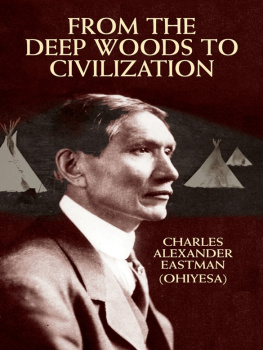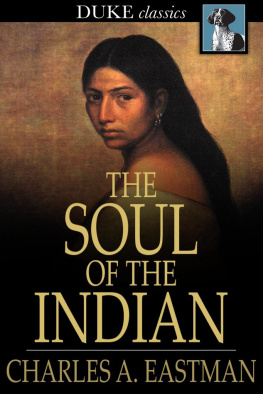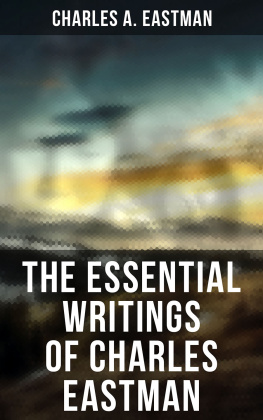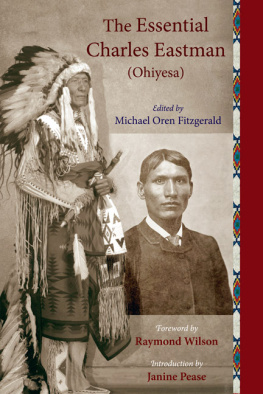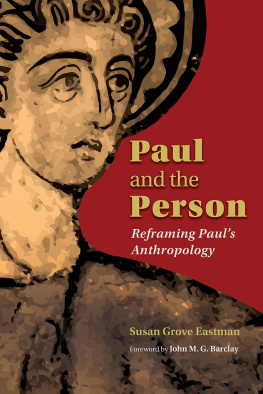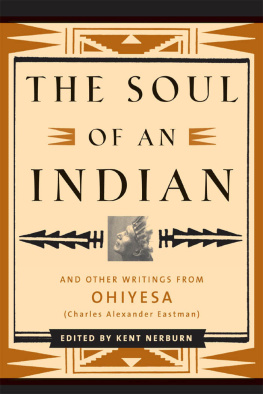Bibliographical Note
This Dover edition, first published in 2003, is an unabridged republication of the work originally published by Little, Brown, and Company, Boston, 1916. For this edition the text has been reset and the illustrations relocated as near as possible to their original position in the book.
Library of Congress Cataloging-in-Publication Data
Eastman, Charles Alexander, 18581939.
From the deep woods to civilization / Charles Alexander Eastman (Ohiyesa). p. cm.
Originally published: Boston : Little, Brown, 1916.
Includes index.
9780486147031
1. Eastman, Charles Alexander, 18581939. 2. Santee IndiansBiography. I. Title.
E99.S22E183 2003
973.049752dc21
[B]
2003048930
Manufactured in the United States of America
Dover Publications, Inc., 31 East 2nd Street, Mineola, N.Y. 11501
I. The Way Opens
One can never be sure of what a day may bring to pass. At the age of fifteen years, the deepening current of my life swung upon such a pivotal day, and in the twinkling of an eye its whole course was utterly changed; as if a little mountain brook should pause and turn upon itself to gather strength for the long journey toward an unknown ocean.
From childhood I was consciously trained to be a man; that was, after all, the basic thing; but after this I was trained to be a warrior and a hunter, and not to care for money or possessions, but to be in the broadest sense a public servant. After arriving at a reverent sense of the pervading presence of the Spirit and Giver of Life, and a deep consciousness of the brotherhood of man, the first thing for me to accomplish was to adapt myself perfectly to natural thingsin other words, to harmonize myself with nature. To this end I was made to build a body both symmetrical and enduringa house for the soul to live ina sturdy house, defying the elements. I must have faith and patience; I must learn self-control and be able to maintain silence. I must do with as little as possible and start with nothing most of the time, because a true Indian always shares whatever he may possess.
I felt no hatred for our tribal foes. I looked upon them more as the college athlete regards his rivals from another college. There was no thought of destroying a nation, taking away their country or reducing the people to servitude, for my race rather honored and bestowed gifts upon their enemies at the next peaceful meeting, until they had adopted the usages of the white mans warfare for spoliation and conquest.
There was one unfortunate thing about my early training, however; that is, I was taught never to spare a citizen of the United States, although we were on friendly terms with the Canadian white men. The explanation is simple. My people had been turned out of some of the finest country in the world, now forming the great states of Minnesota and Iowa. The Americans pretended to buy the land at ten cents an acre, but never paid the price; the debt stands unpaid to this day. Because they did not pay, the Sioux protested; finally came the outbreak of 1862 in Minnesota, when many settlers were killed, and forthwith our people, such as were left alive, were driven by the troops into exile.
My father, who was among the fugitives in Canada, had been betrayed by a half-breed across the United States line, near what is now the city of Winnipeg. Some of the party were hanged at Fort Snelling, near St. Paul. We supposed, and, in fact, we were informed that all were hanged. This was why my uncle, in whose family I lived, had taught me never to spare a white man from the United States.
During the summer and winter of 1871, the band of Sioux to which I belongeda clan of the Wahpetons, or Dwellers among the Leavesroamed in the upper Missouri region and along the Yellowstone River. In that year I tasted to the full the joy and plenty of wild existence. I saw buffalo, elk, and antelope in herds numbering thousands. The forests teemed with deer, and in the Bad Lands dwelt the Big Horns or Rocky Mountain sheep. At this period, grizzly bears were numerous and were brought into camp quite commonly, like any other game.
We frequently met and camped with the Hudson Bay half-breeds in their summer hunt of the buffalo, and we were on terms of friendship with the Assiniboines and the Crees, but in frequent collision with the Blackfeet, the Gros Ventres, and the Crows. However, there were times of truce when all met in peace for a great midsummer festival and exchange of gifts. The Sioux roamed over an area nearly a thousand miles in extent. In the summer we gathered together in large numbers, but towards fall we would divide into small groups or bands and scatter for the trapping and the winter hunt. Most of us hugged the wooded river bottoms; some depended entirely upon the buffalo for food, while others, and among these my immediate kindred, hunted all kinds of game, and trapped and fished as well.
Thus I was trained thoroughly for an all-round out-door life and for all natural emergencies. I was a good rider and a good shot with the bow and arrow, alert and alive to everything that came within my ken. I had never known nor ever expected to know any life but this.
In the winter and summer of 1872, we drifted toward the southern part of what is now Manitoba. In this wild, rolling country I rapidly matured, and laid, as I supposed, the foundations of my life career, never dreaming of anything beyond this manful and honest, unhampered existence. My horse and my dog were my closest companions. I regarded them as brothers, and if there was a hereafter, I expected to meet them there. With them I went out daily into the wilderness to seek inspiration and store up strength for coming manhood. My teachers dreamed no more than I of any change in my prospects. I had now taken part in all our tribal activities except that of war, and was nearly old enough to be initiated into the ritual of the war-path. The world was full of natural rivalry; I was eager for the day.



